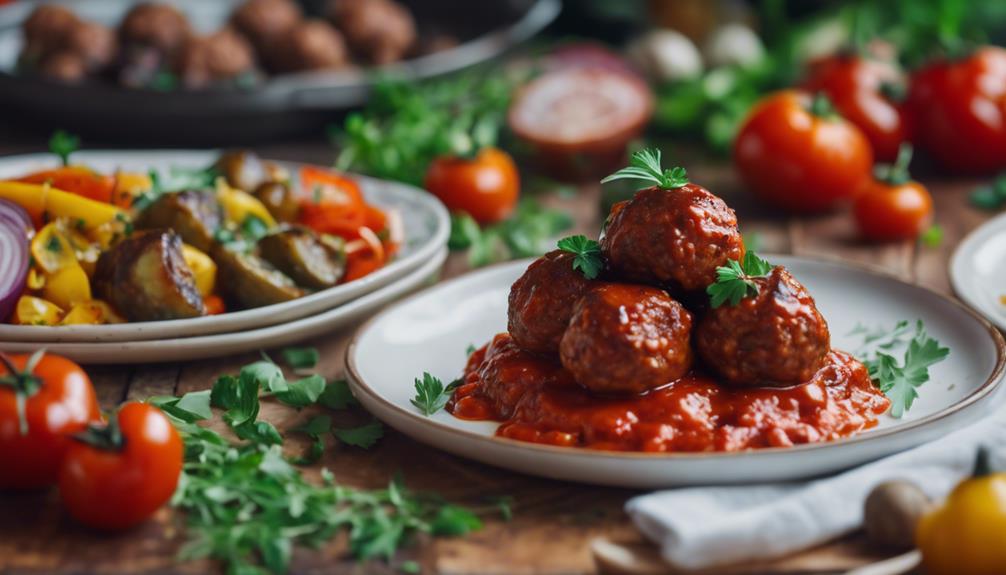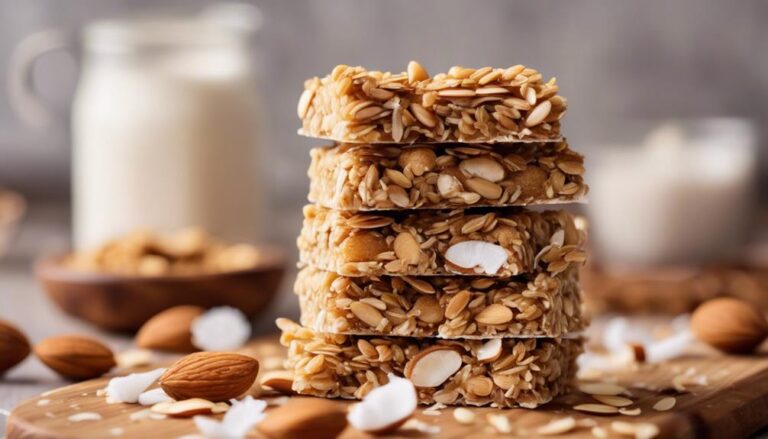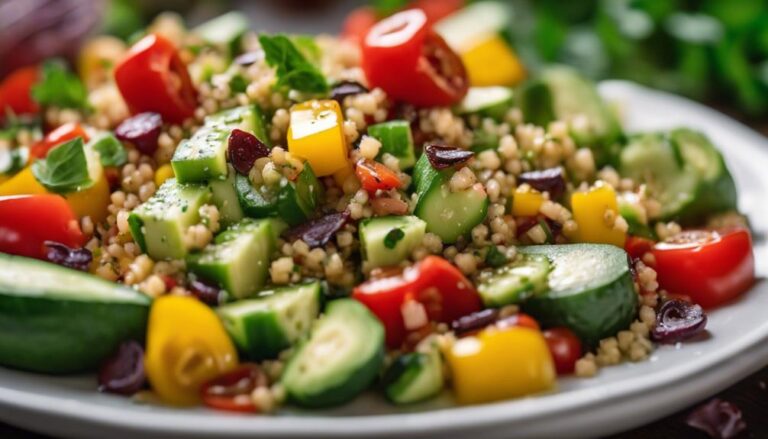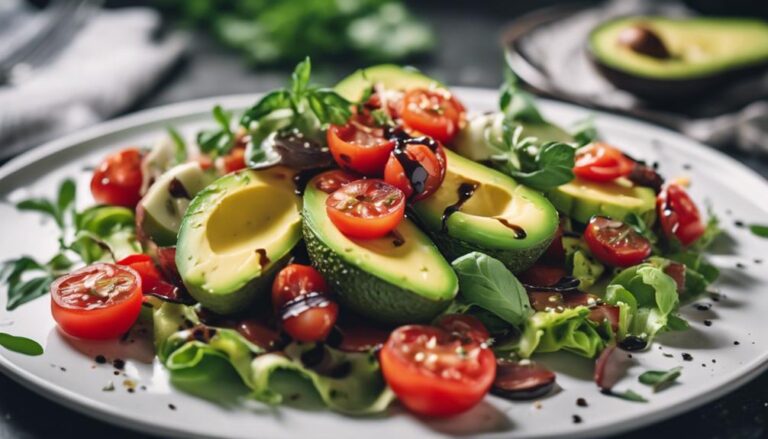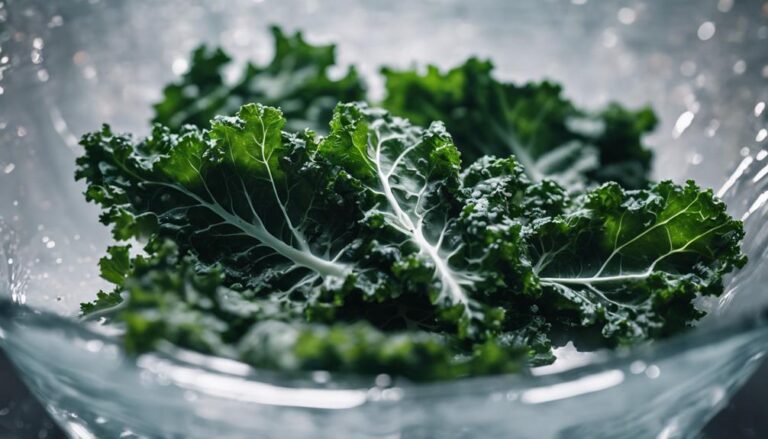Sous Vide Vegan Meatballs With Tomato Sauce: a Daniel Fast Dinner Delight
Discover a delightful Daniel Fast dinner with sous vide vegan meatballs in tangy tomato sauce. Elevate your plant-based cooking with this innovative and flavorful dish. Explore the origins of vegan meatballs, key plant-based ingredients, and top-rated variations for a satisfying meal. Learn how to perfect the consistency and texture of your vegan meatballs. Experiment with different flavors and ingredients for a nourishing dining experience. Uncover the joy of creating and serving delightful plant-based dishes, blending innovation and delicious goodness. Further insights into enhancing your culinary skills and meal planning await.
What You Will Learn Here
- Sous vide technique ensures precise cooking for moist vegan meatballs.
- Tomato sauce adds rich flavor to vegan meatballs, enhancing the dish.
- Daniel Fast dietary guidelines align with plant-based, nutrient-rich ingredients.
- Enjoy a satisfying and flavorful dinner with sous vide vegan meatballs.
- Elevate your plant-based cooking with this delightful and healthy recipe.
Vegan Meatball Origins
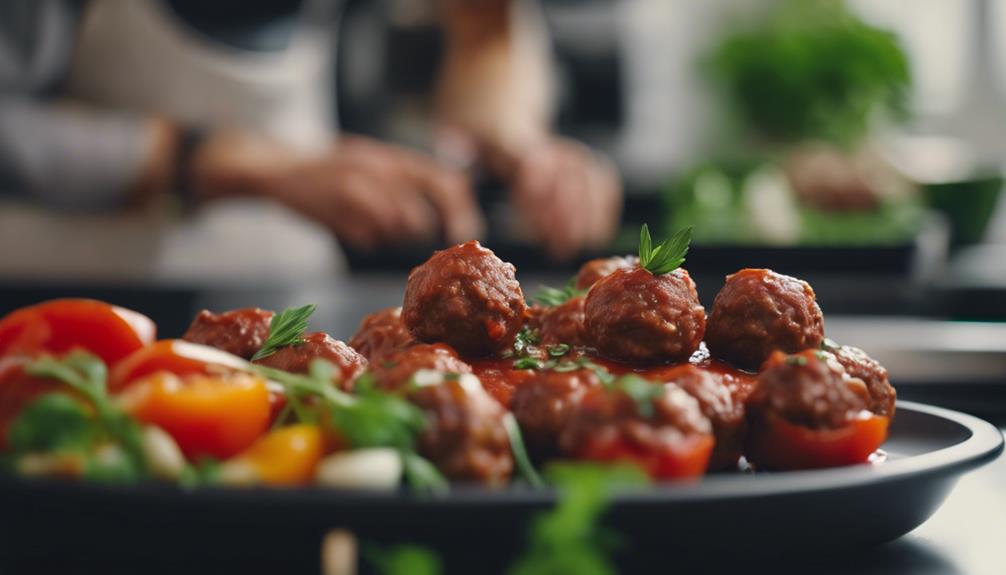
Vegan meatballs have a rich history influenced by various culinary traditions. The inspiration behind these plant-based protein balls can be traced back to diverse sources, including Mediterranean, Middle Eastern, and Asian cuisines.
Modern culinary innovation techniques have allowed for the creation of vegan meatballs that aren't only delicious but also sustainable and nutritious.
Meatball Inspiration Source
Drawing inspiration from various plant-based cuisines around the world, you can trace the origins of vegan meatballs to a rich tapestry of culinary traditions. These meatballs aren't only delicious but also offer numerous health benefits due to their plant-based protein content.
As vegan meatball recipes have evolved, chefs worldwide have put their creative twists on this classic dish, incorporating diverse ingredients like lentils, chickpeas, quinoa, and mushrooms to enhance flavor and texture while boosting nutritional value.
Crucial component of vegan meatballs is plant-based protein, providing essential amino acids for muscle repair and overall well-being. By choosing plant-based proteins over animal products, you can support a healthier lifestyle, reduce your environmental footprint, and enjoy a versatile range of culinary options.
Whether you're following a vegan diet or simply looking to incorporate more plant-based meals into your routine, vegan meatballs with their diverse origins and health benefits offer a delicious and satisfying addition to your dining table.
Plant-Based Protein Choice
You can explore a variety of plant-based protein choices that form the foundation of vegan meatballs' origins across different culinary traditions.
Protein alternatives like lentils, chickpeas, and black beans are commonly used to create delicious and nutritious vegan meatballs. These ingredients not only provide a satisfying texture but also pack a punch of essential nutrients.
Lentils, for example, are a fantastic source of plant-based protein, fiber, and iron, making them a popular choice for vegan recipes.
Chickpeas, on the other hand, offer a creamy texture and are rich in protein, folate, and manganese.
Black beans bring a hearty flavor to meatballs while providing a good dose of protein, fiber, and antioxidants.
Culinary Innovation Techniques
Through a combination of traditional culinary methods and modern innovation, plant-based chefs have reimagined the concept of meatballs to create flavorful and nutritious vegan alternatives.
Flavor infusion plays an essential role in vegan meatball origins, where chefs experiment with various herbs, spices, and plant-based ingredients to develop rich and satisfying tastes that rival traditional meat-based options.
Temperature control is another key aspect of culinary innovation techniques, with the use of sous vide cooking methods allowing for precise temperature regulation to guarantee ideal texture and juiciness in vegan meatballs.
Key Plant-Based Ingredients
Incorporating a variety of nutrient-rich plant-based ingredients is essential for creating flavorful and satisfying vegan meatballs. Here are four key plant-based ingredients to elevate your vegan meatball game:
- Flavorful Seasonings: Enhance the taste of your meatballs with a mix of garlic powder, onion powder, smoked paprika, and Italian seasoning for a burst of savory flavors.
- Versatile Meal Options: Experiment with different legumes like lentils, chickpeas, or black beans as a base for your meatballs to provide a variety of textures and flavors, making them suitable for various dishes.
- Nutrient-Packed Substitutions: Replace breadcrumbs with ground flaxseeds or nutritional yeast to boost the protein and vitamin content of your meatballs without compromising on taste.
- Creative Cooking Methods: Try baking, air frying, or sous vide cooking your vegan meatballs for a healthier twist that retains moisture and enhances the flavors of the ingredients.
Top-Rated Vegan Meatball Variations
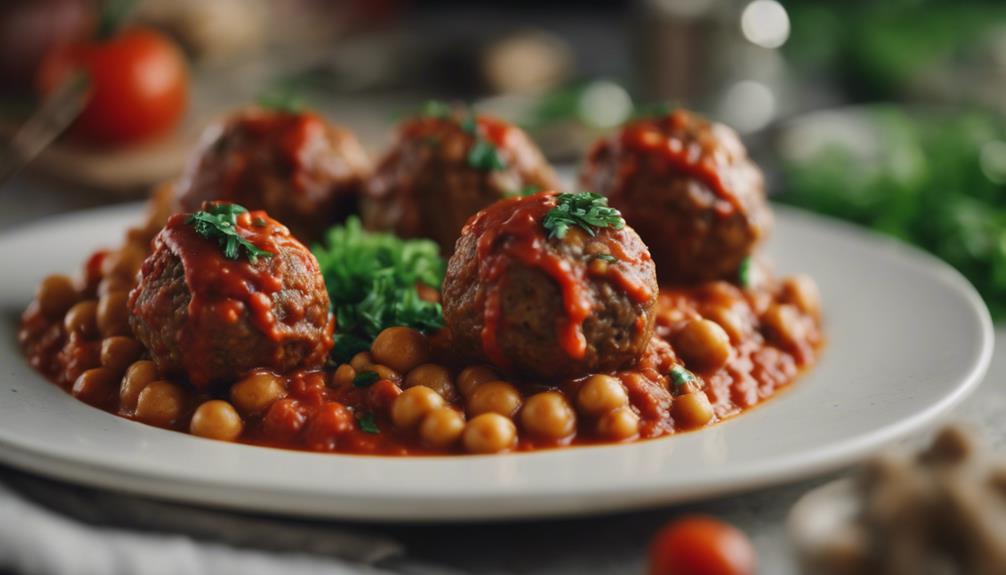
When it comes to top-rated vegan meatball variations, you have a few excellent options to explore.
You can try out Vegan Meatball Sous Vide for a unique cooking method that locks in flavor.
Another popular choice is the Chickpea-Based Vegan Meatballs, packed with protein and a satisfying texture.
If you're looking for a heartier option, the Lentil and Mushroom Vegan Meatballs offer a savory and wholesome alternative.
Vegan Meatball Sous Vide
For top-rated vegan meatball variations, consider exploring the sous vide cooking method to achieve a perfectly textured and flavorful dish. When it comes to vegan meatballs, the sous vide technique offers a host of benefits, enhancing the taste and texture of your plant-based creations. Here are four reasons why you should try making vegan meatballs sous vide:
- Consistent Texture: Sous vide cooking guarantees that your vegan meatballs are evenly cooked throughout, resulting in a tender and juicy bite every time.
- Intensified Flavors: By vacuum-sealing your ingredients before cooking, the flavors are heightened, creating a more vibrant and delicious meatball experience.
- Customizable Creativity: The sous vide method allows you to experiment with a wide range of herbs, spices, and plant-based ingredients, sparking your creativity in crafting unique vegan meatball recipes.
- Elegant Presentation: With sous vide, you can achieve a perfect round shape for your vegan meatballs, elevating the visual appeal of your dish when serving to guests or loved ones.
Chickpea-Based Vegan Meatballs
Consider enhancing your vegan meatball repertoire with flavorful and nutritious Chickpea-Based Vegan Meatballs, a top-rated variation that promises a satisfying plant-based dining experience. These meatballs are bursting with delicious flavors and are simple to prepare using the baking method.
Here are four reasons why you should try these delectable Chickpea-Based Vegan Meatballs:
- Flavorful Seasoning: Infuse your meatballs with a blend of aromatic herbs and spices to tantalize your taste buds.
- Easy Baking Method: Utilize the hassle-free baking technique to achieve perfectly cooked meatballs without the need for constant monitoring.
- Nutritious Ingredients: Benefit from the wholesome goodness of chickpeas, packed with protein and fiber for a nourishing meal.
- Versatile Dish: Serve these versatile meatballs as a main course, appetizer, or even in sandwiches for a delightful dining experience.
Prepare these Chickpea-Based Vegan Meatballs for a delightful and guilt-free meal that will surely impress your guests with its savory taste and healthful ingredients.
Lentil and Mushroom Vegan Meatballs
Enhance your vegan meatball repertoire with the savory and satisfying Lentil and Mushroom Vegan Meatballs, a top-rated variation bursting with rich flavors and wholesome ingredients. These meatballs aren't only delicious but also packed with nutritional benefits and a delightful umami taste. Here's why you should consider adding Lentil and Mushroom Vegan Meatballs to your next meal:
- Lentil Benefits: Lentils are a fantastic source of plant-based protein, fiber, and essential nutrients, making these meatballs a nutritious choice for your diet.
- Umami Flavor: The combination of lentils and mushrooms creates a deep, savory flavor profile that will tantalize your taste buds and leave you craving more.
- Mushroom Substitution: Using mushrooms in place of traditional meat not only enhances the texture of the meatballs but also adds a rich earthiness to the dish.
- Texture Enhancement: The hearty texture of lentils combined with the meaty consistency of mushrooms results in a satisfying bite that will impress both vegans and meat-eaters alike.
Perfecting Vegan Meatball Consistency
To perfect the consistency of your vegan meatballs, focus on achieving the ideal texture through the right combination of binding ingredients.
Selecting the appropriate ingredients to bind your meatballs together is crucial to creating a delicious final product.
Adjusting the cooking time to guarantee that your vegan meatballs are cooked through but still moist and flavorful will elevate your dish to a new level of culinary delight.
Texture for Vegan Meatballs
Achieving the perfect texture for vegan meatballs involves balancing the moisture content with the binding agents to create a firm yet tender consistency.
When considering flavor balance, it's crucial to make sure that the meatball mixture is well-seasoned with herbs and spices that complement the overall dish.
The cooking method you choose can greatly impact the texture of your vegan meatballs. For a moist and succulent result, consider using the sous vide technique, which gently cooks the meatballs in a vacuum-sealed bag at a precise temperature.
This method helps retain the moisture and flavor, resulting in tender meatballs with a perfect texture.
By carefully monitoring the cooking time and temperature, you can achieve meatballs that aren't only delicious but also have the ideal consistency.
Experiment with different cooking times and temperatures to find the perfect balance for your vegan meatballs, ensuring they're a delightful addition to your Daniel Fast dinner.
Binding Ingredients Selection
For achieving the perfect consistency in your vegan meatballs, selecting the right binding ingredients is key to ensuring they hold together well during cooking. When considering binding techniques, ingredients like flaxseed meal mixed with water, breadcrumbs, or ground oats work well to hold the meatballs together. These ingredients not only help maintain the shape but also add a nice texture to your meatballs.
Texture preferences play a significant role in choosing binding ingredients. If you prefer a denser meatball, opt for ingredients like cooked quinoa or mashed beans. On the other hand, if you enjoy a lighter texture, using ingredients such as grated vegetables or cooked lentils can achieve this effect.
Apart from texture, considering flavor profiles is essential. Ingredients like minced garlic, chopped herbs, or nutritional yeast can enhance the taste of your vegan meatballs. Additionally, incorporating ingredients rich in nutritional benefits, such as chia seeds for omega-3 fatty acids or nuts for added protein, can boost the nutritional value of your dish.
Cooking Time Adjustment
Consider adjusting the cooking time to perfect the consistency of your vegan meatballs. Cooking time adjustments can have a notable impact on the texture and flavor of your meatballs.
With sous vide precision, you have the flexibility to experiment with different cooking times to achieve the desired results.
To enhance the taste of your vegan meatballs, try varying the cooking time slightly and observe how it affects the texture. Longer cooking times can make the meatballs more tender, while shorter times may result in a firmer consistency. It's all about finding the perfect balance that suits your preferences.
Experimentation with cooking times is key to mastering the art of vegan meatball making. By adjusting the duration in the sous vide cooker, you can tailor the texture to your liking.
Keep track of your cooking times and the corresponding outcomes to refine your recipe over time.
Final Thoughts

In conclusion, reflect on how these sous vide vegan meatballs with tomato sauce have elevated your plant-based cooking repertoire. By incorporating meal planning and taste testing, you've not only nourished yourself but also those you serve.
The versatility of ingredient substitutions and cooking hacks has allowed you to create a dish that's both flavorful and satisfying, perfect for sharing with loved ones during your Daniel Fast.
As you continue to explore plant-based cooking, remember the importance of experimenting with different flavors and textures to find what works best for you and your guests. These vegan meatballs showcase how simple adjustments can lead to delicious results, encouraging you to think creatively in the kitchen.
Whether you're hosting a dinner party or preparing a weekday meal, these sous vide vegan meatballs with tomato sauce offer a satisfying option that aligns with your dietary preferences. Embrace the joy of cooking and serving others with this delightful dish that celebrates the beauty of plant-based ingredients.
Frequently Asked Questions
Can I Freeze the Vegan Meatballs for Later Use?
Yes, you can freeze the vegan meatballs for later use. To enhance flavors, try different seasonings or sauces before freezing. When meal prepping, freeze them in individual portions for quick and easy leftover ideas.
Are There Any Gluten-Free Options for the Meatball Recipe?
For gluten-free swaps in the meatball recipe, opt for gluten-free breadcrumbs or almond meal. As baking alternatives, consider using an oven instead of sous vide. These changes will make the recipe suitable for gluten-free diets.
Can I Substitute Almond Flour for Breadcrumbs in the Recipe?
Yes, you can substitute almond flour for breadcrumbs in the meatball recipe. Almond flour is a great gluten-free option. Remember, almond flour absorbs moisture differently than breadcrumbs, so adjust accordingly. Consider baking instead of frying for a healthier option.
How Long Can the Vegan Meatballs Be Stored in the Fridge?
To maintain freshness and peak taste, store your vegan meatballs in the fridge for up to 3-4 days. Proper storage is key to preserving the flavor and texture of your dish, ensuring a delightful dining experience.
Can I Use a Different Type of Sauce for the Meatballs?
Yes, you can absolutely use a different type of sauce for the vegan meatballs! Have fun with flavor experimentation by trying out various sauce alternatives to complement your meatball accompaniments and create unique recipe variations.
Conclusion
To sum up, sous vide vegan meatballs with tomato sauce are a delightful and fulfilling option for a Daniel Fast dinner.
By incorporating key plant-based ingredients and experimenting with different variations, you can create a flavorful and nutrient-rich meal that everyone will enjoy.
With a little practice, you can perfect the consistency of your vegan meatballs and impress your family and friends with this healthy and tasty dish.
Try making them for your next meal and experience the deliciousness for yourself!
